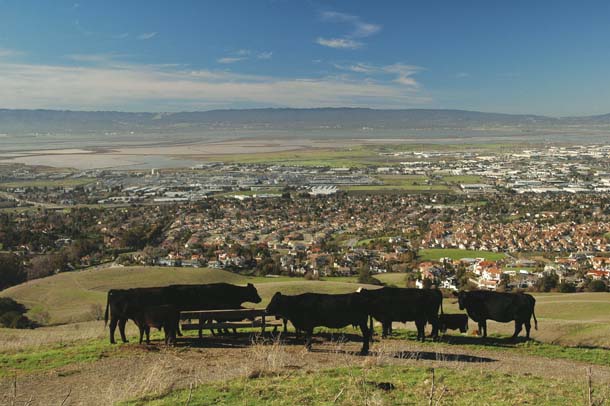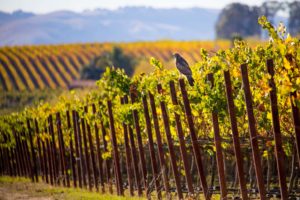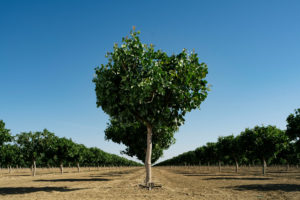One minute you’re hurtling down the freeway near the San Mateo Bridge in the humdrum heart of suburban America. The next you’re time-traveling into Ardenwood Historic Farm past a wooden produce stand and neatly plowed fields to an old-fashioned train station, where the railcars are pulled by a horse named Jiggs. On the footpath near the entrance gate, there’s a white wooden cart full of home-grown strawberries that you pay for on the honor system.
You walk down the lane past a stately Victorian mansion surrounded by formal gardens. Just beyond there’s a big lawn where squirrels, blackbirds, scrub jays, and kids mingle companionably. A peacock struts its colorful stuff. A little girl in red shoes chases a flock of free-ranging Rhode Island Reds. It doesn’t take long to figure out that Ardenwood is not your ordinary hike-bike-and-bird-watch nature park.
Commercial organic farmer Joe Perry presides over the produce stand and the 59 acres he leases for row crops. Now in his seventies, Perry grew up farming in the Fremont area with his father and was steering a horse-drawn plow at age 13. Another 145 acres are devoted to offering visitors hands-on lessons in Bay Area history and agriculture. Using century-old farming methods, volunteers (many three or four feet tall) help the Ardenwood staff grow organic popcorn, Indian corn, wheat, oats, and potatoes. They also help care for one Angus beef cow, one milking shorthorn, six sheep, a handful of goats, a dozen chickens, and some turkeys, rabbits, and pigs.
- The big red barn at Garin Regional Park in Hayward now serves as a visitor center. The Garin family once grew apricots here, and today the park district grows 160 different kinds of apples. Photo by Frank S. Balthis.
Ardenwood and the Little Farm in Tilden Regional Park are the only active farms among 65 East Bay Regional Parks in Alameda and Contra Costa counties. But the park district’s history is thoroughly intertwined with agriculture. The district was founded in 1934 with the idea of “playgrounds for people,” and grazing was not allowed in those early parks in the hills. By the 1960s, however, the district was buying ranch lands to expand its holdings, and then it began keeping cattle on those lands to reduce the fire danger by “mowing” the grass. Today, the district is working with 32 local ranchers, rotating their livestock on and off about half of the 97,600 acres of regional parks. Livestock perform a variety of grassland management services at many district properties, and at a few parks, visitors even get a chance to learn about what’s involved in producing a pound of beef or a loaf of bread.
The Ardenwood mansion and some 6,000 acres around it were once owned by George Washington Patterson. A failed gold-seeker from the Midwest, Patterson limped out of the Sierra to find work as a farmhand around San Jose. He worked hard, saved up, and bought some land. By the time he married in 1877, Patterson was among the wealthiest men in the area.
He lived during the beginning of the Bay Area agricultural boom. As many settlers discovered, there was more money to be made in feeding California’s rapidly growing population than in searching for gold. Over the next 60 years or so the mild climate and fertile soils in this region produced a cornucopia of vegetables, fruits, and nuts–almonds, apricots, cauliflower, grapes, peas, pears, spinach, corn, tomatoes. Most farms also had a few chickens, goats, sheep, and cattle, along with grass and grain to feed them.
In the 1940s, however, farming began its shift from the Bay Area to the Central Valley and to Oregon, Washington, Idaho, and other places where land prices were lower and urban aggravations fewer. “When the war came along people found they could make more money in industry and left the land,” says Ron Mueller, who grew up on a ranch in the East Bay hills. In 1939, about 43,000 acres of Alameda County were devoted to growing fruits, nuts, and vegetables. By 2006 that number had shrunk to 2,500.
.jpg)
- District staff also grow apples–along with strawberries, wheat, and other crops–at Ardenwood Historic Farm in Fremont. Photo by Frank S. Balthis.
Roaming the East Bay Regional Parks today, you’re bound to stumble on evidence of the region’s agricultural past. The grassy hillsides of Briones near Lafayette have been kept free of brush by animals and humans for thousands of years. Elk and pronghorn antelope grazed here, and native people set fires to encourage the growth of certain plants they used for food. Later Spanish and Mexican settlers grazed cattle, followed by American homesteaders and ranchers. In the early 1800s, this land fattened Felipe Briones’s cattle on Rancho Boca de la Canada del Pinole. In the 1860s, new owners Simon and Elias Blum added orchards and vineyards, as well as crops of hay, grain, and vegetables. Today, the cattle remain, as does a nine-acre pear orchard. Not much is known about the pear trees except that they were planted at the turn of the last century, around the same time that John Muir was raising fruit at his home in nearby Martinez.
Twenty miles south of Briones, at what is now Pleasanton Ridge Regional Park, Thermal Fruit Company grew apricots, prunes, and almonds until 1930. There’s also a mystery grove of century-old olive trees. At Camp Ohlone in Sunol Regional Wilderness, some walnut trees are a reminder of the Swedish subsistence farmer who once owned the property. An old asparagus farm east of Brentwood will soon make way for a park that offers public access to the Sacramento River Delta.
The purchase of what is now Sunol Regional Wilderness in 1962 was a turning point in the district’s attitude toward livestock. The elk, pronghorn, and regular fires that had shaped the landscape for thousands of years were gone, but there were still nearby ranches with cows and sheep. So with an eye toward fire prevention and a little income, the district allowed the livestock to stay. Today some 5,000 cattle, 1,000 sheep, and 1,000 goats are grooming the district’s grasslands.
At Garin Regional Park, a mourning dove coos and a visitor trains a spotting scope on a red-tailed hawk’s nest near a big red barn, the park’s visitor center. In the 1880s, the Garin family established an apricot orchard here, which they sold to the park district in the 1960s. Since then, the district has replaced the apricot trees with 160 different kinds of apples, heirloom varieties that were once commercially important but have since almost disappeared. The park celebrates the harvest with an apple festival in September. Inside the barn, which is open on weekends, are a blacksmith shop, several exhibits, and an array of antique farm machinery and tools.

- Cattle surround a picnic table at Mission Peak Regional Preserve. Since the 1960s, the district has allowed cattle and other livestock to graze on its land. Park staff monitor rangelands to ensure sufficient cover remain cover remains to prevent erosion and sustain wildlife. Photo by Ambarish Goswami.
Ron Mueller is the supervisor of Garin and neighboring Dry Creek regional parks. He’s a beefy, strong-looking man who grew up on a ranch that is now part of Las Trampas Regional Wilderness near San Ramon. When I meet him, his khaki shirt is smudged with dirt from working in the garden around Dry Creek Ranch, which was donated to the district in 1979. He shows me an area outside his office that is excluded from grazing and has become a thriving thicket of head-high coyote bush. In grazed areas, he says, “the cattle end up munching down a lot of the undesirable plants, so the plants that have a hard time competing against the real tall grasses have a chance to pop up.”
Mueller says that when cows were first allowed on park lands, “there wasn’t much thought given to keeping an eye on the cattle.” In some cases ranchers grazed the park lands “down to dirt.” But today, park supervisors are required to survey their rangelands regularly and manage cattle in an effort to keep at least a thousand pounds per acre of “residual dry matter” left in grazed areas to leave cover for wildlife and protect soil from erosion. That means grass about six to eight inches high–not in every spot, but on average. Within that framework, the exact formula varies depending on the goals at a given park. In a park near houses, the goal might be fire safety. In Round Valley Regional Preserve near Antioch, the goal is to protect the endangered kit fox, which has an easier time finding prey in grazed areas.
In 2008 cows were removed early in many parks due to scant spring rainfall. In Garin that meant an exit in mid-May instead of mid-June. I ask Laura Comstock, the district’s unit manager who oversees this process, if the district has stocking levels and timing all figured out. Not yet, she admits. “But we have to do everything we can to manage grazing. These aren’t just ranches we let people walk through. They’re parks.”
At a dinner the East Bay Regional Park District held for its grazing licensees last spring, there was beef and barbecued chicken, and talk of unseasonal heat and drought. “We had a tenth of an inch of rain last night,” says Lucky Gravette, whose cows graze in the Ohlone wilderness. “But we had six-tenths of an inch of wind the next day, so I’m not sure it all adds up.” The deeply tanned rancher furrows his brow. If more moisture doesn’t arrive soon, “we’ll have to sell,” he says, meaning that he’ll have to shrink the size of his herd to match the available forage on parklands and his own ranch.
Gravette says ranchers need public understanding, so they don’t have to sell their lands to “some jackass who builds a 10,000-square-foot house.” The district is still working on building that understanding, if not for the ranchers themselves, at least for its collaboration with them. A district brochure about grazing makes the case that well-run agricultural operations in the parks can reduce fire danger and benefit native plants and animals. It also tries to address some of the complaints it has received, everything from serious concerns about overgrazing and aggressive cows to more trivial ones: “Like all other animals, cows produce manure,” the brochure states, “so visitors must watch their step.”
When I express an interest in local ranching history, a couple of ranchers at the dinner urge me to speak with Tim Koopmann. They point across the room to a man a head taller than most of the rest of us, with glasses, a dark mustache, and a white hat. Koopmann’s family came to California from Italy and Germany in the 1860s and 1870s. They started out in Half Moon Bay and sharecropped their way to Dublin. In 1918, his grandfather and great uncle bought what is today the family’s “home ranch” north of Sunol Regional Wilderness.

- Parents and children watch a springtime sheep-shearing demonstration at Ardenwood Farm. Photo by Galen Leeds.
At first Koopmann’s forebears farmed the gentler slopes and later grew some grapes. “In those days,” Koopmann says, “places tended to be self-sufficient. People didn’t have a cell phone in one ear.” In addition to their row crops, they’d have a milk cow and some pigs and poultry. They’d grow their own hay to feed the livestock.
Today, Koopmann raises cattle on the home ranch while working as a watershed resource specialist for the City of San Francisco, which leases some of its East Bay watershed lands back to the Regional Park District. His family’s once-remote 900-acre ranch is now surrounded by a golf course, some ranchettes, and Interstate 680. He doesn’t lease land from the park district, but properties like his benefit adjacent public lands by adding to the mosaic of open spaces. “We can’t buy everything,” says the district’s Comstock. “Ranches provide linkages that wildlife needs. Otherwise the parks would end up being little islands, and ranchers would move to greener pastures in Wyoming or Montana or Idaho.”
Koopmann is proud to say his land still supports two endangered species: the California tiger salamander and the callippe silverspot butterfly. “The butterflies rely on Johnny-jump-ups, or Violas, which like light to moderately grazed property.”
But it’s awkward being a rancher on the urban edge. “You have to put up with uneducated neighbors,” Koopmann says. People trespass, leave gates open, and break or cut down fences. “I don’t want my cattle on the golf course or the freeway.”
Despite the difficulties, Koopmann thinks the ranch has a future, and both his kids have studied agriculture in college. “It’s the heritage, and the history, and the blood, sweat, and tears–and my son and daughter,” he says. “There’s just something that makes us want to hold on.”
Compared to Koopmann’s spread, Ardenwood, with its wide-eyed children and period-costumed staff, may seem like Disneyland. But part of Ardenwood’s purpose is to educate people like Koopmann’s neighbors–to help them understand the processes and people that provide their food.
Among park visitors, there’s no shortage of interest. At Ardenwood’s two-day harvest festival last October, some 7,000 visitors come to watch and help. They load wagons with sheaves of wheat from the fields–then, a few steps away from the fields, they thresh and mill the grain, emerging covered in flour. Someday soon, staff farmer Paul Lewis hopes to market Ardenwood’s organic wheat to East Bay restaurants and bakeries. “It’s locally grown food–absolutely current.”
At sheep-shearing time in April, Carol Pike, an elegant silver-haired volunteer, is sitting at a spinning wheel showing some children how to spin wool into yarn. A rapt 10-year-old boy helps her twist a strand of tawny wool by hand. “It’s a wonderful thing that we have in the parks,” says the former elementary-school principal, “having kids be amazed that wool makes cloth and an acorn makes food.” For years, both Ardenwood and Tilden’s Little Farm have helped fill that gap for urban kids. “The Little Farm was the only connection that lots of kids had with a live cow, pig, or goat,” says retired chief naturalist Ron Russo. “On a Sunday, we’ve had 600 people up there watching a cow drop a calf.”
Over by Ardenwood’s sheep-shearing corral, I lean on the fence next to a visitor whose wiry build suggests she’s less a tourist than the rest of us. Sure enough, she grew up on a farm in the Central Valley. Did she work hard as a kid? “Heck yeah. We grew all our own food. Never had store food until I was 21.” Most of the rest of the onlookers are children and parents. “I think it should be mandatory for them to come out and experience this,” she says. “They’ll be better people for it. You put a young person with a baby goat–I don’t care how tough they are, they still make a connection with that animal. An animal can soften any heart.”
Sheep shearing and wool spinning and wheat farming may seem a long way from the East Bay Regional Parks’ “people’s playground” mission of the 1930s. But the district’s founders didn’t live in the world we inhabit. They didn’t have the science to know that grazing and burning had shaped the very land they were trying to preserve. They couldn’t have foreseen that locally produced food would become a sought-after commodity. And they couldn’t have imagined that their children’s children would be unclear about where their food and fiber come from.
“Now Ardenwood is an island surrounded by suburbia,” says staff farmer Paul Lewis. “No one is to blame. But you don’t see a field of wheat very often.”

.jpg)




